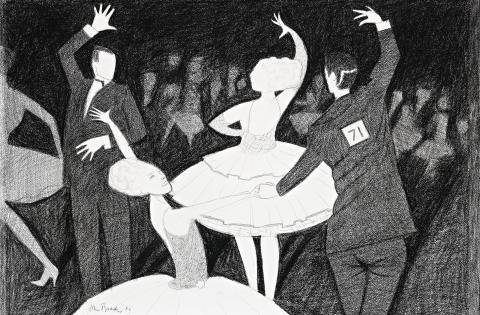SKETCH FOR BACKS AND FRONTS, 1969
JOHN BRACK
conté on paper
44.5 x 65.5 cm
signed and dated lower left: John Brack 69
Rudy Komon Gallery, Sydney
Gwen Frolich, Sydney
Thence by descent
Private collection, Sydney
John Brack, Rudy Komon Gallery, Sydney, 8 – 25 April 1970, cat. 21
Grishin, S., The Art of John Brack, Oxford University Press, Melbourne, 1990, vol. II, cat. p137, pp. 57, 215 (illus.)
Millar, R., Brack, Lansdowne Press, Melbourne, 1971, p. 109
Lindsay, R., John Brack: A Retrospective Exhibition, National Gallery of Victoria, Melbourne, 1987, p. 124
Backs and Fronts, 1969, oil on canvas, 115.5 x 163.5 cm, private collection, in Grishin, vol. I, cat. o206, p. 112 (illus.)
‘I found a parallel between the jockeys and the dancers. Both have turned what should be a pastime into serious professional work. I was interested, too, in the man-woman relationship of the dancers. Almost all professional dancing teams are married so it is not so much romantic love as a 50-50 business contract.’1
Although the ballroom dancing theme had long captivated John Brack’s imagination, it was not until late 1967 that he began to seriously gather material for the celebrated series, subscribing to The Australasian Dancing Times and attending the World Ballroom Dancing Competitions held at Melbourne’s Festival Hall. While not a dancer himself, he was attracted to the subject for its sheer absurdity; as he later remarked, ‘I have been so fascinated by the idea of people who turn pleasure, pastime, into work, labour and it is most exactified in professional ballroom dancing.’2 Certainly, it is no coincidence that Brack should embark upon such a series within a year of his own decision to resign as Head of Melbourne’s National Gallery Art School and support his family exclusively through his work as a professional artist. More significant perhaps, was the opportunity Brack perceived within this highly choreographed ritual to explore the human condition itself – the intricacies of relationships, both real and simulated; the struggle for individuality; maturity, performance and ultimately, survival.
Executed in 1969, the present conté drawing is a preparatory study for one of the two culminating paintings of the Ballroom Dancing series, namely Backs and Fronts, 1969 (private collection) – the other major work being Latin American Grand Final, 1969 in the collection of the National Gallery of Australia, Canberra. While Brack drew upon extensive photographic material for most of his Ballroom Dancing series, notably it was only in these key works that he attempted the difficult feat of employing two photographs spliced together to achieve a confronting composition. Accordingly derived from Maurice Stowbridge’s photographs of Ray and Judy Rivers, and Donald Woods and Merrilyn Royal respectively, Backs and Fronts presents two couples whirling through space on the dance floor, with a judgmental crowd of onlookers waiting darkly in the background. Notwithstanding Brack’s obvious fidelity to his sources, however, Grishin astutely notes that ‘…upon closer examination it could well be the same man or the same woman being presented from the back and front – thus possibly highlighting the faceless ritual involved in the pursuit.’3
For indeed, beyond a purely literal analysis of Brack’s design exists an arguably more compelling commentary upon the dance here as a visual metaphor for life itself – an allegory of the human condition in the vein of great European masters such as Goya and Munch. Depicting his dancers poised in difficult and exacting poses, balanced over highly polished floorboards with their reflections inviting imminent collapse, thus Brack exposes the extreme vulnerability and precariousness of the participants. Moreover, that they are tightly bonded together in relationships that are merely a well-rehearsed ritual, full of superficial glitter but devoid of deeper meaning, poignantly alludes to the inherent loneliness and tragedy of human existence.4 Balancing sympathetic engagement with cold cerebral judgment, it is undeniably a vision where paradox reigns supreme – elegance and absurdity, sophistication and vulgarity, attraction and repulsion, passion and indifference. As Ronald Millar perceptively elucidated in the introduction to the 1970 exhibition of the series,
‘John Brack’s lissom ballroom dancers…re-state in more indirect terms than before all his long-standing preoccupations. Obsessions about states of uneasy poise and about vulnerability: ideas about personal uses for very impersonal objects, about the physical and psychological make-believe, and about realities behind facades. About people being alternately attracted and repelled, together intimately but separated in motive and intention. About the rituals of art and life, about the unity that asserts itself over the perilous and unstable set of contesting circumstances.’5
Unfortunately, however, at the time of the works’ inaugural exhibition, many critics mistakenly discerned only a sneering superiority on Brack’s behalf with Donald Brook labelling the works ‘a new mockery of lowbrow and démodé art forms’6, and Daniel Thomas objecting to the artist’s disdain for dancing, ‘If it’s fairly clear that Brack doesn’t understand what dancing is and doesn’t take to the dance floor himself, it’s also clear that he’s not in love with ballroom dancing as a spectacle…’7 By contrast, today Brack’s superb Ballroom Dancing compositions are not only considered among the artist’s finest achievements but importantly, the series remains widely revered as one of the most iconic in the history of Australian art.
1. Brack cited in Dunstan, K., ‘A Place in the Sun: Reporting a Comeback, Cha-cha-cha’, Sun, Melbourne, 7 October 1970, p. 9
2. ‘John Brack on John Brack’, 1977, cited in Grishin, S., The Art of John Brack, Oxford University Press, Melbourne, 1990, vol. I, p. 105 – 6
3. Grishin, ibid., p. 107
4. ibid.
5. Miller, R., ‘Foreword’, John Brack, Georges Gallery, Melbourne, 1970
6. Brook, D., ‘Bathos in the Ballroom’, Sydney Morning Herald, Sydney, 9 April 1970, p. 12
7. Thomas, D., ‘Brack’s dance’, Sunday Telegraph, Sydney, 12 April 1970, n.p.
VERONICA ANGELATOS
